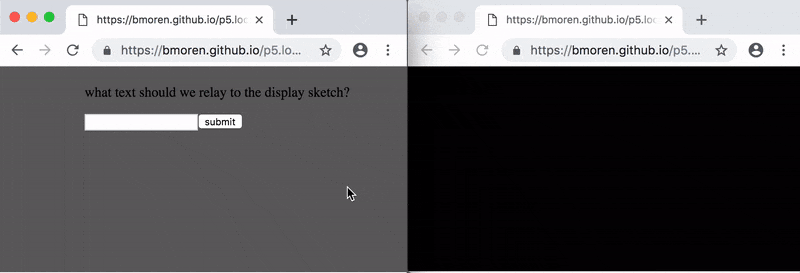p5.localmessage
p5.localmessage provides a simple interface to send messages locally from one sketch to another. This is a very useful tool for multi window sketches, or allowing sketches to communicate with one another across multiple displays connected to the same machine. A typical application is having one sketch as a controller window and another sketch as the visual output.
This is a prerelease software. At some point it might be expanded – maybe even to include a bunch of other service worker things that would be cool to use in p5.js.
How to Add a library to your p5.js sketch
Important tips & known limitations
- You must register the
service-worker.jsfile using theregisterServiceWorker()function in thesetup()before you begin. - currently p5.localmessage will NOT work with the p5.js web editor. Consider moving your project to an external editor with your own web hosting setup.
- Be aware that not all browsers support service workers, or all functionality of service workers. Check the JS console for errors. When in doubt, try another browser! (testing shows best functionality currently in CHROME)
- The word clients in the documentation below refers to other pages opened on the same URL with the same service worker enabled.
- This library will only work if you're running sketches from the same domain.
- There are full sketch examples in the various example folders
- The
sendMessage()'s message cannot be anything beyond a base datatype, so strings, booleans, JSON objects, numbers, and floats are great, but p5 objects likecolor()will not be able to be sent.
Live Examples
- Basic Example (open the console on all pages, click the page to interact)
- Draw Example (Click the page to interact)
- Basic Communication between a controller sketch & display sketch
- Advanced Communication with multiple pieces of data
License
p5.localmessage is licensed MIT just like the service worker cookbook it's based upon.
p5.localmessage table of contents:
registerServiceWorker()
registerServiceWorker('path/to/service-worker.js')
Registers the service worker which conducts the message relay using a relative path to the service-worker.js file from the main sketch.js file. You must do this first. This interface is provided so you can organize your files however you'd like. The example below is representative of how this would look on the provided examples.
function setup() {
registerServiceWorker('../service-worker.js')
}sendMessage()
sendMessage('the message to send')
sendMessage() sends a message to other clients, it will not send the message to itself. This can be any datatype, including a JSON object which can be used to send more complex data! This can be used in the draw() loop for real time interaction across windows!
sendMessage() basic example:
function mouseClicked(){
//this will only go to the other clients that are connected (not itself).
sendMessage('hello world! with a unique message: ' + random(100))
}sendMessage() JSON example:
function mouseClicked(){
//package up data as a JSON object
let person = {
"name": "amy",
"height": "5.75",
"skills": "programming"
}
//send the message
sendMessage(person)
}listenMessage()
listenMessage(callback)
listenMessage() listens for incoming messages from other clients. It will ignore messages from itself! It takes a callback function which will be fired each time a new message arrives. The incoming data to the callback is a JSON object containing 2 keys. client and message.
client is the unique client ID #. example: 955a9982-7a12-4dae-babc-18789401f141 which can be used to identify specific clients that are sending messages.
message contains the message that the client sent. Keep in mind that if the client sends JSON, it'll need to be traversed accordingly.
Note: Do NOT put the listenMessage() function in the draw() loop, as this will continually add event listeners to the page and may cause issues. Use it in the setup()! You can use a temporary variable to relay things in the draw() loop, see the draw_example folder for a complete example of this functionality.
function setup() {
//only listening to messages sent from other clients (it ignores itself.)
listenMessage(function(incomingData){
//the incoming data has 2 keys, client and message
console.log(incomingData.client, incomingData.message)
})
}
